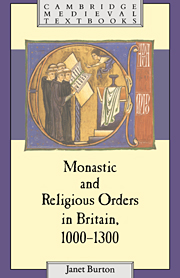Book contents
- Frontmatter
- Contents
- List of illustrations
- Preface
- 1 Before the Normans
- 2 The coming of the Normans
- 3 The regular canons
- 4 The new monastic orders of the twelfth century
- 5 Women and the religious life
- 6 The mendicant orders
- 7 The physical setting: monastic buildings and the monastic plan
- 8 Inside a religious house: daily life and the chain of command
- 9 Learning and literary activities
- 10 Religious houses and the wider community: founders, patrons and benefactors
- 11 The monastic economy
- 12 On the brink of change
- Glossary
- Notes
- Select bibliography
- Index
- Cambridge Medieval Textbooks
4 - The new monastic orders of the twelfth century
Published online by Cambridge University Press: 05 June 2012
- Frontmatter
- Contents
- List of illustrations
- Preface
- 1 Before the Normans
- 2 The coming of the Normans
- 3 The regular canons
- 4 The new monastic orders of the twelfth century
- 5 Women and the religious life
- 6 The mendicant orders
- 7 The physical setting: monastic buildings and the monastic plan
- 8 Inside a religious house: daily life and the chain of command
- 9 Learning and literary activities
- 10 Religious houses and the wider community: founders, patrons and benefactors
- 11 The monastic economy
- 12 On the brink of change
- Glossary
- Notes
- Select bibliography
- Index
- Cambridge Medieval Textbooks
Summary
Perhaps the most striking feature of medieval monastic history is the proliferation of new religious groups and orders in the late eleventh and early twelfth centuries. These were the product of a search for the purest, indeed the perfect, form of monasticism, and are characterized by two main features: the desire to return to primitive monastic observances, either to the eremiticism of the Desert Fathers or to a stricter interpretation of the text of the Rule of St Benedict; and the appeal of apostolic poverty. Both these carried implicit, sometimes indeed explicit, criticisms of the religious life as practised in contemporary monastic houses, and led to what has been termed the ‘crisis of monasticism’. These new trends and new religious emotions can be investigated through an examination of four religious orders which, in a greater or lesser degree, transformed monastic life in Britain. These are the orders of Tiron, Savigny, Citeaux (the Cistercian Order), and La Grande Chartreuse (the Carthusian Order). This is also an appropriate place to consider the military orders, which, although their aims differed widely from those of the conventional orders, were nevertheless heavily influenced by the Cistercians, and made a unique contribution to the development of the monastic life of the period. Of all these groups, the Chartreuse was the first to be founded and the last to reach Britain. And it was the Cistercian Order which was to exert more influence in Europe than any other medieval religious order, although it perhaps had the least auspicious beginning of all.
- Type
- Chapter
- Information
- Monastic and Religious Orders in Britain, 1000–1300 , pp. 63 - 84Publisher: Cambridge University PressPrint publication year: 1994

